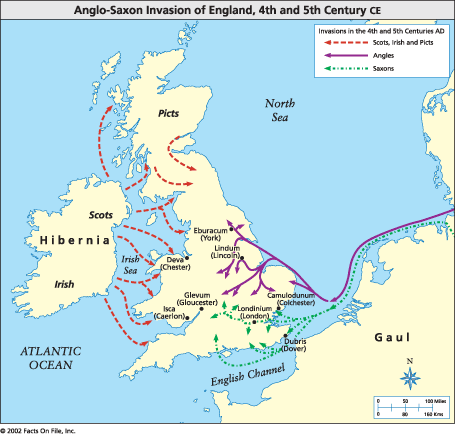
According to the Anglo-Saxon Chronicle, Cerdic arrived off the coast of Britain with his son, Cynric, and a fleet of five ships in the year 495 and landed near Southhampton (Hampshire), or what the chronicle calls “Cerdic’s-ore.” That day, they fought against an army of Welsh troops.
In the year 508, Cerdic’s army slew Natanleod, a British king, along with five thousand of his men, and afterwards, the land was named Netley, as far as Charford.
Ten years later, in 519, the chronicle says Cerdic and Cynric founded the government of the West Saxons, and in that same year, they fought and defeated the Britons at Charford, establishing the reign of the West-Saxon kings.
A.D. 527 – Cerdic and Cynric fought against the Britons at Cerdic’s-ley, and in 530 A.D., they took the isle of Wight and defeated the Britons at Carisbrook.
In 534, Cedric, the first king of the West-Saxons, died. Cynric succeeded to the throne and reigned twenty six years. The exact date of Cedric’s birth is unknown.
There are competing historical theories surrounding the reign of Cerdic. Some historians claim Cerdic’s reign lasted between 538-554 A.D., slightly later than what is suggested in the Anglo-Saxon chronicle, though since the chronicle was actually compiled sometime in the late 9th century, it is likely the chronicle is not entirely accurate. Other historians believe Cerdic was the leader of the Saxons at the Battle of Mount Badon, where the the British defeated the Saxons and kept them from pushing farther into Wales. *It’s intersting to note that some historians believe the legend of King Arthur arose out of the Battle of Mount Badon, as “Arthur” was the leader of the Britons who held off the Saxons during this battle.
Also, archaeological evidence suggests that the locations mentioned in the chronicle about Cerdic and the origins of Wessex may not be entirely accurate either. And yet another competing theory claims Cerdic was not a real person at all, but a purely legendary figure who represented the founding of the Anglo-Saxon tradition in medieval Britain that would last for 500 years.
Sources:
“Anglo-Saxon Chronicle.” Trans. James Ingram. London: 1847. Ancient and Medieval History Online. Facts On File, Inc. http://www.fofweb.com/activelink2.asp?ItemID=WE49&iPin=amdoc001&SingleRecord=True (accessed November 24, 2008).
O’Brien, Patrick K., gen. ed. “Cerdic.” Encyclopedia of World History. Copyright George Philip Limited. New York: Facts On File, Inc., 2000. Ancient and Medieval History Online. Facts On File, Inc. http://www.fofweb.com/activelink2.asp?
ItemID=WE49&iPin=ewh01201&SingleRecord=True (accessed April 7, 2009).
*image retrieved from Facts on File, Inc.
Because of the many Briton names in tjeir family Cerdic/Ceretc, Cynric/Cunorix were most likely sub Roman Briton officials using Saxons to establish themselves as rulers of Wessex after Rome was no longer able to exert control
R, thanks for the interesting info!